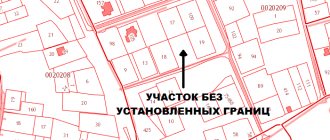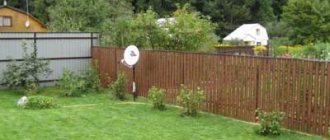Seizure of land plots by law
Any plot of land may be confiscated by agreement or court decision. But most often this happens in relation to those that have permitted use for agricultural needs.
The legislative basis is:
- Civil Code (Articles 284-286).
- Land Code (Articles 44-47).
- Federal Law No. 101-FZ “On the turnover of agricultural lands” (the reason for the seizure from the owner is indicated as improper use).
The Civil and Land Codes of the Russian Federation regulate three procedures for the seizure of land plots:
- For the needs of the state and municipalities. In this case, they must necessarily reimburse the funds for it, which will be obtained as a result of sale at public auction, or provide a similar plot of land in another place.
- The land is confiscated from the owner by court decision, without payment of funds. Compensation is provided only for persons affected by the criminal activities of the owner of the site. The money after the auction will be transferred as material or moral damage. The former owner will not receive anything from the confiscation of the land. According to Art. 243 Civil Code, Art. 50 ZK, Art. 104 of the Criminal Code.
- It is also possible to recognize the land as ownerless if, after registering the land with the cadastral register, the ownership rights to it have not been registered with a certain person for more than five years. Such plots become the property of the municipality and can be leased or owned by citizens. This basis is prescribed in Law No. 251-FZ.
Let us note that previously there were only a few rules in the Land Code of the Russian Federation regarding the procedure for the seizure of plots. Federal Law No. 499-FZ introduced amendments that came into force on April 1, 2015, which allocated an entire chapter in the code (Chapter VII.1 of the Land Code of the Russian Federation) dedicated to resolving issues of land seizure from owners.
Conditions
Forced confiscation from the owner of his land plot is permitted in cases directly stipulated by the legislator. The provisions governing land relations are reflected in the Civil Code and Land Code of the Russian Federation. It states that plots can be confiscated for government needs. This applies not only to government agencies, but also to the municipality. In addition, the basis for withdrawal is that there is a need to develop a specific territory in a comprehensive plan. The Republic of Kazakhstan reflects that there must be a decision made by the authorities.
Plots can also be seized if:
- cases of land use for which the intended purpose was violated were identified;
- when the allotment is requisitioned or confiscated.
Each of these situations assumes that if the owner refuses to comply with the demands of the authorities, this will lead to forcible seizure of the plot. Sometimes a citizen can expect that he will be paid compensation in the future, taking into account the cost of the site. If a person does not agree with the calculations made, he has the right to appeal to the judge.
Grounds for land seizure
There are several reasons why an owner may lose rights to land, but this procedure can only occur under significant circumstances. The grounds under the law are the following:
- When the owner exploits the land in violation of the permitted use, as well as non-use.
- For the integrated development of the territory, an official decision of the authorities, if the site is within the boundaries of the planned work.
- Confiscation to compensate for damage caused by the owner to another person due to his criminal act.
- Requisition due to the effects of epidemics, natural disasters, accidents and emergencies.
- Other circumstances when, within the framework of legislation, authorities at any level have the right to reclaim the site.
- For state or municipal needs. These include:
- construction of federal, as well as local or regional facilities in a specific territory;
- carrying out work within the framework of subsoil use;
- fulfillment of the Russian Federation's international obligations;
- within the framework of state powers by the FSB service;
- other grounds under the legislation of the Russian Federation.
It is important to know that the owner cannot refuse to comply with a court order to seize land. In most cases, he can only count on another similar allotment or compensation payments.
The procedure for forced seizure of a land plot
The seizure of a land plot within the framework of the law occurs in several stages. Each of them is mandatory. In case of any violation, the owner has the right to go to court to restore the violated rights. The procedure can be described step by step as follows:
- Initiating the withdrawal process. Authorities at any level can launch it. The owner is sent a notification letter about the date of verification of the intended purpose of the land. Unscheduled inspections may also be carried out.
- Search for owner.
- Making a decision on confiscation. Based on the initiative, the authorized bodies make a decision on the seizure of land. The resolution indicates the reason for the confiscation, the owner from whom the plot is confiscated, as well as the details of this plot: area, cadastral number and others that make it possible to initiate a specific territory.
- Written notice to the owner that the land will be expropriated for cause. In parallel with this, the executive bodies publish information in the media with data on the seized property.
- An agreement is being developed. Only after reaching all agreements, a document is drawn up, which indicates all the features of the procedure, indicating the deadlines. The condition for replacing lost property is also stated here.
- The land plot is alienated and the rights to it are transferred. If the confiscation does not occur as a result of a court decision, according to which the compensation of funds to the injured person will occur, then the owner of the land has the right to demand compensation. It is calculated according to the market valuation in force in a specific territory. Instead of monetary compensation, the copyright holder who has lost property may be offered a replacement equal in area or price.
After notification, the property owner has 3 months to make a decision. During this time, he may agree to the terms of the seizure, the amount of compensation, or replacement with a similar plot. Otherwise, contact the judicial authorities with a claim of violated rights. As practice shows, state authorities have all legal grounds for confiscation of a land plot and the court makes a decision in favor of the state.
If the land has not been registered, the owner is given only 2 months to prove his rights regarding the allotment. He is obliged to submit the title documents and application to the administration. Otherwise, the land will be declared ownerless and transferred to the municipality.
As for compensation for lost property, it consists of several components:
- market valuation of the site itself;
- immovable objects located within the boundaries of the allotment. It should be noted here that compensation for them is possible only if the permitted use of the land involves the placement of such objects on them;
- lost profits that could have been received by the owner in connection with the use of the land, again in accordance with the permit;
- other amounts of damages.
In the event that real estate objects were not registered as legal property, no compensation is provided for them. Since they will be recognized as unauthorized construction and subject to demolition.
If the authorities have other property at their disposal in terms of value, it may be offered to the owner in exchange for what was lost during seizure. Another option is cash, the amount of which is made up of the above components.

If agricultural land or land provided for construction (as well as gardening) is not used for these purposes, fines are levied at increased rates. Responsibility for violations of the procedure for using land plots can also be established in the legislation of the constituent entities of the Russian Federation. In addition to liability, misuse of a site may lead to other adverse consequences, such as termination of rights to it or refusal to issue a building permit. The land plot must be used for its intended purpose in accordance with its category and in accordance with its permitted use. This follows from paragraph 2 of Art. 7, art. 42 of the Land Code of the Russian Federation. Possible types of permitted use of land plots are listed in the Classifier (approved by Order of the Ministry of Economic Development of Russia dated September 1, 2014 N 540). Information about the category and permitted use of the land plot is indicated in the documents for the land, contained in the Unified State Register and is given in the issued extract from the Unified State Register (clauses 3, 4, part 5, article 8, part 1, article 21, part 6, art. 62 of the Law on State Registration of Real Estate). For the use of a land plot not in accordance with the category of land or permitted use, liability is established in the form of a fine in the following amounts (Part 1 of Article 8.8 of the Code of Administrative Offenses of the Russian Federation):
| Who is involved | The amount of the fine if the cadastral value of the land plot is established | The amount of the fine if the cadastral value of the land plot is not established |
| Citizens | 0.5 - 1% of the cadastral value, but not less than 10,000 rubles. and no more than 100,000 rubles. | 10,000 - 20,000 rub. |
| Officials, including individual entrepreneurs | 1 - 1.5% of the cadastral value, but not less than 20,000 rubles. and no more than 300,000 rubles. | 20,000 - 50,000 rub. |
| Organizations | 1.5 - 2% of the cadastral value, but not less than 100,000 rubles. and no more than 700,000 rubles. | 100,000 - 200,000 rub. |
Please note the following cases in which prosecution under Part 1 of Art.
8.8 of the Code of Administrative Offenses of the Russian Federation, confirmed by judicial practice: 1) non-targeted activities are carried out in a building located on a land plot and do not correspond to the permitted use of the land plot. For example, if the land plot is provided:
- for production purposes, and in fact there is a building on it with a sign “Household Goods Ant”, where they sell household goods (Resolution of the Supreme Court of the Russian Federation dated 08/03/2017 N 14-AD17-6);
- for the operation and maintenance of a complex of buildings and structures of the production site, and is used for the placement and maintenance of a shopping center (Resolution of the Supreme Court of the Russian Federation dated July 18, 2016 N 43-AD16-6).
2) non-purpose activities are carried out only on part of the land plot. The use of part of a land plot not in accordance with its permitted use entails a violation of the regime of use of the land plot. This conclusion is confirmed in the Resolution of the Supreme Court of the Russian Federation dated March 24, 2016 N 31-AD16-3 and the Resolution of the Presidium of the Supreme Arbitration Court of the Russian Federation dated June 18, 2013 N 71/13 in case N A67-4294/2012;
3) the person who uses the land plot for other than its intended purpose, for example, a tenant (even if a lease agreement has not been concluded) is held liable (see Resolution of the Supreme Court of the Russian Federation dated July 2, 2018 N 33-AD18-3).
Responsibility for violations of the procedure for using a land plot may also be provided for by the legislation of a constituent entity of the Russian Federation.
Responsibility provided for non-use of agricultural land:
Responsibility is established for violation of the regime for the use of land plots from agricultural lands, except for those lands that are not covered by the Law on the Turnover of Agricultural Lands (Article 8.8 of the Code of Administrative Offenses of the Russian Federation). The following are held liable if the land plot is not used:
1) for three or more years to conduct agricultural production or other related activities. During this period, the time when the site could not be used due to circumstances that preclude its use, for example, a natural disaster is not counted (part 2 of article 8.8 of the Code of Administrative Offenses of the Russian Federation, article 284 of the Civil Code of the Russian Federation, clauses 3, 4 of Art. 6 of the Law on the Turnover of Agricultural Land). The list of signs by which it is established that a land plot is not in use was approved by Decree of the Government of the Russian Federation of April 23, 2012 N 369.
The fine for this offense is (Part 2 of Article 8.8 of the Code of Administrative Offenses of the Russian Federation):
| Who is involved | The amount of the fine as a percentage of the cadastral value of the land plot |
| Citizens | 0.3 - 0.5%, but not less than 3,000 rubles. and no more than 100,000 rubles. |
| Officials, including individual entrepreneurs | 0.5 - 1.5%, but not less than 50,000 rubles. and no more than 300,000 rubles. |
| Organizations | 2 - 10%, but not less than 200,000 rubles. and no more than 700,000 rubles. |
2) within a year for the intended purpose after you purchased it at public auction.
Moreover, previously such a site (Part 2.1 of Article 8.8 of the Code of Administrative Offenses of the Russian Federation): - was seized by a court decision due to the fact that it was not used for its intended purpose or was used in violation of the requirements of the legislation of the Russian Federation;
- according to information from the land supervision authorities, it was not used for its intended purpose or was used in violation of the requirements for three years or more.
In this case, the amount of the fine is (Part 2.1 of Article 8.8 of the Code of Administrative Offenses of the Russian Federation):
| Who is involved | The amount of the fine as a percentage of the cadastral value of the land plot |
| Citizens and individual entrepreneurs | 0.1 - 0.3%, but not less than 2,000 rubles. and no more than 100,000 rubles. |
| Organizations | 1 - 6%, but not less than RUB 100,000. and no more than 700,000 rubles. |
Liability provided for non-use of a land plot intended for construction:
As a general rule, if such plots are not used for three years for the purposes for which they are provided, you may be fined (Part 3 of Article 8.8 of the Code of Administrative Offenses of the Russian Federation, Article 284 of the Civil Code of the Russian Federation ).
The fine for this offense is (Part 3 of Article 8.8 of the Code of Administrative Offenses of the Russian Federation):
| Who is involved | The amount of the fine if the cadastral value of the land plot is established | The amount of the fine if the cadastral value of the land plot is not established |
| Citizens | 1 - 1.5% of the cadastral value, but not less than 20,000 rubles. and no more than 100,000 rubles. | 20,000 - 50,000 rub. |
| Officials, including individual entrepreneurs | 1.5 - 2% of the cadastral value, but not less than 50,000 rubles. and no more than 300,000 rubles. | 50,000 - 100,000 rub. |
| Organizations | 3 - 5% of the cadastral value, but not less than 400,000 rubles. and no more than 700,000 rubles. | 400,000 - 700,000 rub. |
The same liability is provided for non-use of a land plot intended for gardening (Part 3 of Article 8.8 of the Code of Administrative Offenses of the Russian Federation).
Other consequences of inappropriate use of land:
In addition to administrative liability, misuse of a land plot may entail, in particular, termination of the lease of the plot at the initiative of the lessor, termination of the right to permanent (indefinite) use of the land plot (clause 1, clause 2, article 45, clause 2, article 46 of the Land Code RF).
If the plot is privately owned, it can be forcibly seized in court and sold at public auction in accordance with Art. 54.1 of the Land Code of the Russian Federation:
- when a plot of agricultural land is not used for such activities. This will be possible three years after this fact is revealed (clause 3 of Article 6 of the Law on the Turnover of Agricultural Land);
- when an unauthorized building is erected on the site (Part 6, Clause 2, Part 12, Article 55.32 of the Civil Code of the Russian Federation).
If a site with unauthorized construction is state or municipal property, then the following consequences are possible:
— the lessor can unilaterally terminate the contract (clause 4 of article 46 of the Land Code of the Russian Federation);
- the right to lifelong inheritable possession or permanent (indefinite) use of a plot can be forcibly terminated, and the plot seized by decision of the executive body (clause 6.1 of Article 54 of the Land Code of the Russian Federation).
Rights to a plot of land with unauthorized construction may be terminated if the developer or owner of the land plot does not comply within a certain time frame with the requirements for the demolition of the unauthorized construction or its bringing into compliance with established requirements.
Failure to comply with the documents submitted to obtain a construction permit and the permitted use of the land will result in a refusal to issue a construction permit (Part 13, Article 51 of the Civil Code of the Russian Federation).
Latest news in 2021
Significant changes in legislation affected Federal Law No. 218-FZ “On State Registration of Real Estate”. Now all real estate must undergo cadastral registration and the registration databases must contain information about the owner. At the same time, all lands that have not undergone re-registration and are not included in the Unified State Register of Real Estate risk being confiscated.
It should be noted that the authorities will not immediately take away land from citizens. First, measures will be taken to notify the owner and offer to register in a new format. If this does not happen, the site will be considered abandoned. The basis for this is a court decision if the owner of the land did not appear at the meeting or voluntarily renounced the rights to it. Then this plot will be transferred to the municipality for further disposal at its discretion.
The fate of land seizure could also affect summer residents who built residential buildings and other capital buildings on their plots, but did not register them, starting in the summer of 2021. The dacha amnesty, announced to legalize such buildings under a simplified scheme, has been extended until the spring of 2021. This makes it possible to undergo state registration of houses without a building permit. Without receiving title documents for the land and the buildings on it, the owner may legally lose this property.
In 2021, the State Duma adopted a number of amendments to legislative acts regarding unauthorized construction. The owner on whose land there is an illegal building will first be ordered to demolish it. If this requirement is not fulfilled within the prescribed period, in addition to a fine, which can reach up to 50 thousand rubles, the plot may be seized. Self-construction can include not only a residential building, but also other buildings on a plot of land that are not registered in Rosreestr.









